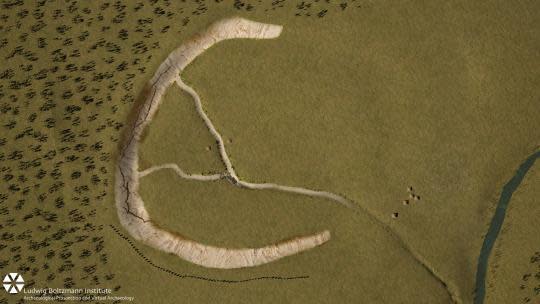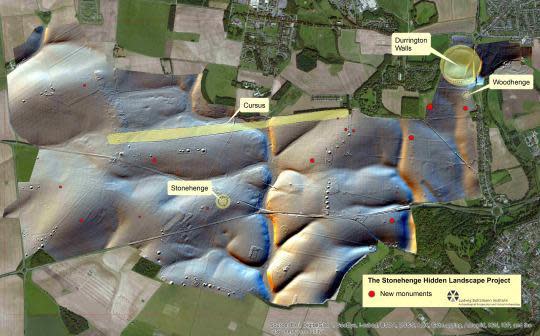11 Things You Need to Know About Superhenge

The newly discovered monument is made up of 90 large stones. (Photo: Ludwig Boltzmann Institute)
If you thought Stonehenge was impressive, wait until you see Superhenge!
On Sept. 7, scientists at the British Science Festival unveiled evidence showing the presence of an ancient Neolithic monument buried beneath the ground. The rock formation is located just two miles away from Stonehenge, and while scientists have yet to dig it up, they believe the rocks at this site are taller and possibly older than Stonehenge.
As we wait to see just how big this discovery is, here are 11 things you need to know about Superhenge:
1. This thing is big.
This large Neolithic settlement is being referred to superhenge because it’s five times the area of Stonehenge.
2. It’s old… like, really old.
Researchers predict that that the rock formation could be as old or older than Stonehenge. That means the monument was likely built 4,500 years ago.
3. It has six times more stones than Stonehenge.
The Neolithic monument consists of a row of 90 standing stones. The main structure of Stonehenge has merely 15 large standing stones.
4. It could be taller than Stonehenge.
The tallest rocks of Stonehenge measure at 13 feet. Researchers predict that some of the newly discovered stones may have originally measured up to 15 feet.
Related: I Flew to Stonehenge for This? The Biggest Bucket List Busts

The new stones are located along the lower edge of Durrtington Walls. (Photo: Ludwig Boltzmann Institute)
5. You can find it just around the corner.
Located just two miles away from Stonehenge, this newly found monument is located along the lower edge of Durrington Walls, a Stone Age enclosure and one of the largest known henge monuments.
6. The rocks were hiding.
The stones are currently buried about three feet under the earth and were detected using ground penetrating radar. It appears as if they were (probably intentionally) pushed over and a bank of earth was built over them.
Related: #Daydream: Stonehenge
7. It’s cut from the same stone.
Stonehenge is made of sarsen stones, sandstone blocks that are found in large quantities on the Salisbury Plain in the United Kingdom. While researchers still need to dig out the newly discovered monument, they believe that Superhenge is also made of the same stone.
8. The rocks were used in rituals.
It’s believed that Superhenge was used as a Neolithic ritual site and incorporates lunar and solar alignments.

The Stonehenge Hidden Landscape Project is dedicated to revealing all of the hidden treasures in the area. (Photo: Ludwig Boltzmann Institute)
9. This finding is important to science.
With the discovery of these stones, scientists are learning more about Stonehenge, the surrounding landscape, and the builders of the time.
10. We still don’t know exactly how it was used.
This new finding, along with Stonehenge, Durrington Walls and 17 other ritual sites found in the area likely have a relationship with each other. However, researchers still don’t know what it is.
11. Researchers were shocked to find it.
“We don’t think there’s anything quite like this anywhere else in the world,” said lead researcher Vince Gaffney of the Ludwig Boltzmann Institute. “This is completely new and the scale is extraordinary.”
WATCH: The Ancient Oasis Towns of Oman: An Explorer’s Dream
Let Yahoo Travel inspire you every day. Hang out with us on Facebook, Twitter, Instagram, and Pinterest. Check out our original adventure travel series, “A Broad Abroad.”

